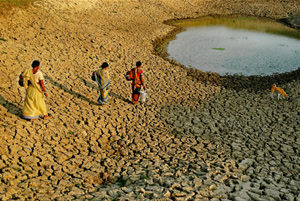
Washington Post Looks at “Water Wars” in India – But forgets Climate Change!
 UPDATE (April 3, 2013) – The Washington Post has updated the story to include climate as a reason for variability in water supplies. While the original did not discuss climate change, the addition of this in the fourth paragraph, plus the inclusion of a quote from former Environment Minister Jairam Ramesh now complete the story. We applaud them for updating the story. The post below reflects concerns about the original story.
UPDATE (April 3, 2013) – The Washington Post has updated the story to include climate as a reason for variability in water supplies. While the original did not discuss climate change, the addition of this in the fourth paragraph, plus the inclusion of a quote from former Environment Minister Jairam Ramesh now complete the story. We applaud them for updating the story. The post below reflects concerns about the original story.
Today, the Shymantha Asokan in Washington Post writes about water shortages in India, saying “Indian States fight over River Usage.” The article in the print edition is titled “Water Wars in Thirsty India” – apparently the only editor didn’t want to be as sensational as the print editor. However, the authors and the editor missed the big story that will drive water shortages in the future – climate change.
The article gives a good view of how water is becoming an important point of legal conflict between states in India, and it briefly touches on the rising international tensions between India and China over water flows in their shared transboundary river, the Brahmaputra.
In the article, they dance around the topic of climate change, but it is never mentioned. For example, it says:
India’s river disputes “have become more severe, and they will continue to become more severe,” said Ashok Jaitly, a water expert who sits on a national government committee that is drafting a law on water management. “Water use is increasing, but the supply is fixed.”
But that’s not true. Climate change means that, while water use is increasing, the supply does not remain fixed. In fact, the supply is becoming ever more variable. There are two factors that have long been seen as constant in India, but in the age of climate change, will no longer be: flows from ice and snow melt in the Himalayas and the annual monsoon.
The great rivers of Northern India – the Ganges, the Indus, and the Brahmaputra – are dependent upon meltwaters from the Himalayas in the dry season. Due to climate change, the region is seeing a rapid increase in temperatures on the Tibetan Plateau – where the climate is warming twice as fast as the rest of the world. ASP’s “Dams of the Himalayas” report, released last November, shows how the adaptation measures being put in place by national governments (more dams) may actually serve to worsen international relations and foment conflict.
The annual monsoon is a date long celebrated and anticipated in India – as the arrival of rains in late May or June breaks the oppressive heat. Unfortunately, in recent years, the monsoon – which could be counted on like the tides or the seasons, has become ever more variable and unpredictable. In the future, some climate models predict that the monsoon will fail completely.
Asokan’s article begins to anticipate the importance of cliamte change when the reporter talks to a farmer in the southern state of Tamil Nadu, saying:
The canal should have been full from last June until the end of the year, he said, but it stood dry, except for one month in which unexpected storms flooded the canal and destroyed his crops.
In the past, “we could just use the rainwater,” said Valan, who like many Tamils has only one name. “But the rains are becoming more unpredictable, so certainly the river is becoming more important.”
The logical next sentance would have pointed to predictions saying that climate change could alter water supplies in South Asia, with the potential for conflict. They could have pointed to the U.S. Intelligence Community’s report on Global Water Security which specifically mentions water shortages in India as a future threat, or they could have looked to the Senate Foreign Relations Committee Report on “Avoiding Water Wars in South and Central Asia” which specifically links climate, water, and conflict.
I wonder if leaving out consideration of climate change was a conscious decision by the author or the editor, or if it was an oversight. Either way, it is a problem. The media must connect the dots – it looks like they’re deliberately avoiding controversy if they do not.
You shouldn’t overlook the threats of climate change in South Asia! Tomorrow (Wednesday, April 3), ASP is hosting Major General Muniruzziman, President of the Bangladesh Institute for Peace and Security Studies, who will be talking about water conflict in his country and the region. Space is still available.
ASP’s work on climate impacts in this region shows the important links between water, climate, conflict, US Policy, and regional security. Reporters should not overlook those linkages.






[…] Washington Post Looks at “Water Wars” in India – But Forgets Climate Change Andrew Holland […]